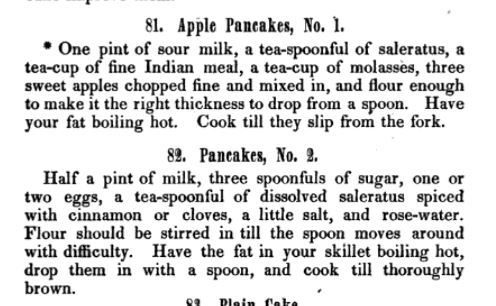Sept 21st
After supper last night, by way of variety Anna, Miriam and I came up to our room, and after undressing, commenced popping corn, and making candy in the fireplace. We had scarcely commenced, when three officers were announced, who found their way to the house to get some supper, they having very little chance of reaching Clinton before morning, as the cars had run off the track. Of course we could not appear; and they brought bad luck with them, for our corn would not pop, and our candy burned, while to add to our distress the odor of broiled chicken and hot biscuits was wafted upstairs, after awhile in the most provoking way. In vain we sent the most pathetic appeals by each servant, for a biscuit apiece, after our hard work. Mrs Carter was obdurate until tired out with messages, she at last sent us an empty jelly cup, a shred of chip beef, two polished drumsticks, and half a biscuit divided in three. With that bountiful repast we were forced to be content, and go to bed.
-Southerner, Sarah Morgan, September 21st, 1862.
This recipe is for the most basic, old fashioned popcorn balls. In the 1860s, popcorn balls were a popular treat bought from street peddlers or "candy boys". Sometimes the balls were dyed red or other colors. Sorghum and corn were two of the few things the south had during the war years. Shortly after the war there were a few purported children's deaths due to poisoned popcorn balls in newspapers. Whether they actually happened or were just to discourage children from eating them is unknown.
 |
| The Housekeeper's Encyclopedia (1861) |
Old Fashioned Civil War Era Popcorn Balls
- 16 Cups of popped Popcorn (1/2 Cup of un-popped kernels)
- 2 Cups Syrup ( Sorghum, Molasses, Honey, Maple)
- Butter or oil for coating hands.
Instructions:
Boil your syrup in a medium saucepan until it reaches 235°F (soft ball stage). Pour the syrup over the popcorn and mix in with a spoon. Let cool until you can touch it with your hands. Coat your hands in butter, scoop up some popcorn and press it into balls. Let sit overnight if yo want to keep the ball shape or eat straight away.
 |
| The Union, Delaware, 08 Sept. 1865 |
 |
| The Gallipollis Journal, Ohio, 29 Oct. 1863 |
 |
| Bangor Daily, Maine, 10 Jan 1865 |
 |
| Bangor Daily, Maine, 09 Jan 1864 |






















